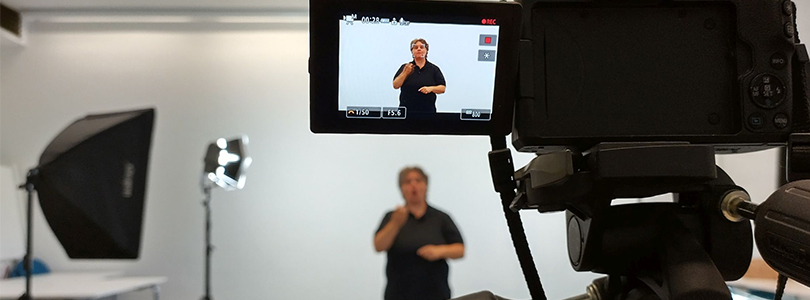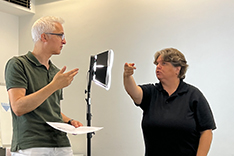Content
How our sign language videos are created

"Hands talk, eyes listen"
Newly published here are videos about our electronic services in German Sign Language (DGS). Why do we publish DGS videos? There are around 80,000 deaf people in Germany. Around 250,000 of them use German Sign Language, or DGS for short, including those who are hard of hearing and people with electronic hearing prostheses. DGS uses hand movements - the signs - but also facial expressions, mouth movements and body posture. It has an extensive vocabulary and its own grammar. The Barrier-free Information Technology Ordinance (BITV 2.0) stipulates that the most important information must also be provided in German Sign Language. The aim is to enable deaf people to participate better.
In addition to the DGS videos "What does the DPMA do?", "How to find your way around our website" and the "Declaration on accessibility" required by BITV 2.0, we offer information that goes beyond the information required by the BITV with the films now published.
We produce our sign language videos in-house

Daniela Herde and Martin Kleinsorge during the video recordings
The special thing about our sign language videos is that we produce them ourselves, from the initial idea to the final cut. Our colleague Daniela Herde translated all the videos into German sign language and also signs in the video. She herself has been deaf since birth and is a trained sign language teacher. She is accompanied by Dr. Martin Kleinsorge, who is a patent examiner in his main profession and also the general representative of severely disabled people.
We asked Daniela Herde what sign language videos are good for, what tips she has for dealing with deaf people and whether there is an international sign language.
Three questions for Daniela Herde
You often hear the question: Why do you need extra DGS videos? Deaf people can read. Why are these videos important? And what does visual sign language mean to you?
Daniela Herde: Language develops through hearing and this also applies to written language. This is why deaf people find it difficult to understand complex issues in written language. For the majority of deaf people, sign language is their mother tongue. However, sign language has a completely different, independent grammar and is not a sign language. In addition to the signing hands, the mouth, facial expressions, direction of gaze and upper body posture are all part of the language. The sign language videos therefore help to ensure that the website is barrier-free.

Daniela Herde
Incidentally, sign language has been recognized as an independent language for over 20 years. This is stated in the Federal Disability Equality Act. However, we don't feel disabled, we are a linguistic minority.
Ms. Herde, you are a sign language lecturer and deaf yourself. What is important in the interaction between deaf and hearing people?
Daniela Herde: For me, it is very important to build a bridge between deaf and hearing people. The deaf want the joy of dialog! And we are dependent on visual perception because we can't hear. For me (also for the deaf), accessibility would be if everyone learned a bit of sign language. There are courses here at the adult education center, for example. I have also taught there.
My personal experience is that deaf people can be insecure when communicating with hearing people, just as hearing people are insecure when communicating with deaf people. The following tips can contribute to communication that is satisfactory for both sides:
- Make contact: Wave your hand or nod your head. This lets the deaf person know that you want to talk to them. Please do not speak from behind! The deaf person will not hear you.
- Eye contact: Only start speaking when the other person is looking at you and maintain eye contact when speaking.
- Good lighting: Make sure that your face is well lit (avoid backlighting, otherwise the deaf person will be dazzled and will not be able to see clearly).
- Topic of conversation: Announce the topic of conversation at the beginning.
- Announce questions: Announce your questions. Say: "I'm asking you!" Then ask your question. "W questions" are easier to understand: Who, what, when, why, where, where to...?
- Clear mouth picture: Speak with a clear mouth picture (= mouth movements), but not exaggerated. Otherwise your mouth image will be distorted.
- Speak slowly: Speak at a slower pace.
- Don't shout! Speak at a normal volume. Shouting is useless as the deaf person cannot hear you.
- Short sentences: Use short but complete sentences. Avoid foreign words.
- Write things down: Write down important information (appointments, names, addresses).
- Everything understood? Always make sure that you have understood everything correctly. Ask what has been understood. Don't be afraid to repeat yourself. Clarify misunderstandings openly and in a friendly manner.
- Gestures, facial expressions and body language: Support what you are saying with natural gestures, facial expressions and body language. This helps understanding and replaces what is conveyed in spoken language with the speech melody.
- Sign language interpreters? You can also hire an interpreter.
Is German Sign Language actually spoken everywhere or are there regional differences? And is there actually an international sign language?
Daniela Herde: The vocabulary of sign language is not standardized nationwide, but has different dialects, comparable to the German language (in Bavaria, for example, people speak and sign differently than in North Rhine-Westphalia).
Furthermore, sign language is not international. Every country has its own sign language, which has developed through various influences, just like spoken languages. For example, there is German sign language, American sign language and many others.
Pictures: DPMA
Last updated: 10 December 2025

Not only protecting innovations
Social Media